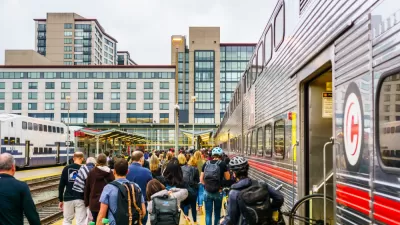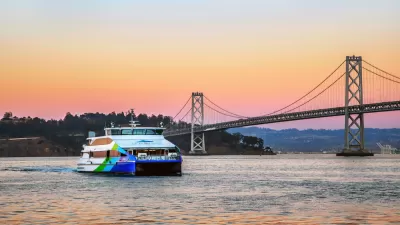After 25 years, Santa Clara's light rail has failed to live up to its promise, proving to be “among the least successful in the nation” reports Mike Rosenberg, while “serving as a constant reminder that the car is still king in Silicon Valley."
Despite expanding out over a stretch of 42.2 miles, with 62 stations, and serving 32,000 one-way commuters, Silicon Valley's VTA system is still considered to be one of the most costly, slow, inefficient and under-utilized in the nation, writes . It cost $2 billion to build and costs $66 million a year to operate. Each vehicle costs 30 percent more than the national average to operate and carries 30 percent fewer passengers. And the system is heavily subsidized by taxpayers, at the second worst rate in the nation. Critics see it as an innately flawed failure, yet advocates point to decreased freeway traffic while remaining optimistic that usage will increase in years to come.
VTA transportation manager Kevin Connolly contrasts its failures with San Francisco's successes, “[i]n our case we tried to graft a big-city transit type of mode onto a suburban environment, and it's still kind of a work in progress." Routes were planned along onion fields, rather than along existing, dense corridors, and “the density never materialized in Silicon Valley,” notes Rosenberg.
Those who remain optimistic acknowledge there is much improvement to be made. "In general, we can't lose sight of the fact that we have to do the basics better," says Connolly. "We have to be faster, we have to connect with better destinations." Proposals in the pipeline include adding more tracks for express trains, as well as reductions in service costs, which could lead to more funding.
FULL STORY: 25 years later, VTA light rail among the nation's worst

Planetizen Federal Action Tracker
A weekly monitor of how Trump’s orders and actions are impacting planners and planning in America.

Map: Where Senate Republicans Want to Sell Your Public Lands
For public land advocates, the Senate Republicans’ proposal to sell millions of acres of public land in the West is “the biggest fight of their careers.”

Restaurant Patios Were a Pandemic Win — Why Were They so Hard to Keep?
Social distancing requirements and changes in travel patterns prompted cities to pilot new uses for street and sidewalk space. Then it got complicated.

Platform Pilsner: Vancouver Transit Agency Releases... a Beer?
TransLink will receive a portion of every sale of the four-pack.

Toronto Weighs Cheaper Transit, Parking Hikes for Major Events
Special event rates would take effect during large festivals, sports games and concerts to ‘discourage driving, manage congestion and free up space for transit.”

Berlin to Consider Car-Free Zone Larger Than Manhattan
The area bound by the 22-mile Ringbahn would still allow 12 uses of a private automobile per year per person, and several other exemptions.
Urban Design for Planners 1: Software Tools
This six-course series explores essential urban design concepts using open source software and equips planners with the tools they need to participate fully in the urban design process.
Planning for Universal Design
Learn the tools for implementing Universal Design in planning regulations.
Heyer Gruel & Associates PA
JM Goldson LLC
Custer County Colorado
City of Camden Redevelopment Agency
City of Astoria
Transportation Research & Education Center (TREC) at Portland State University
Camden Redevelopment Agency
City of Claremont
Municipality of Princeton (NJ)





























